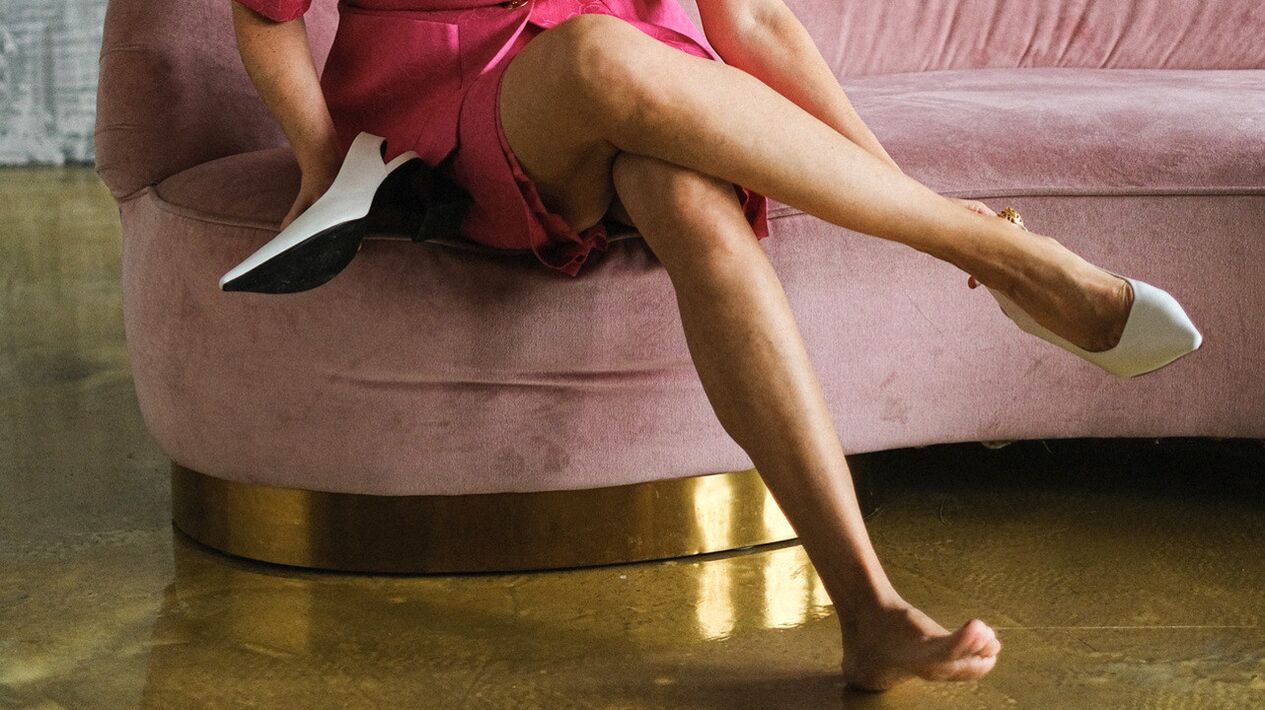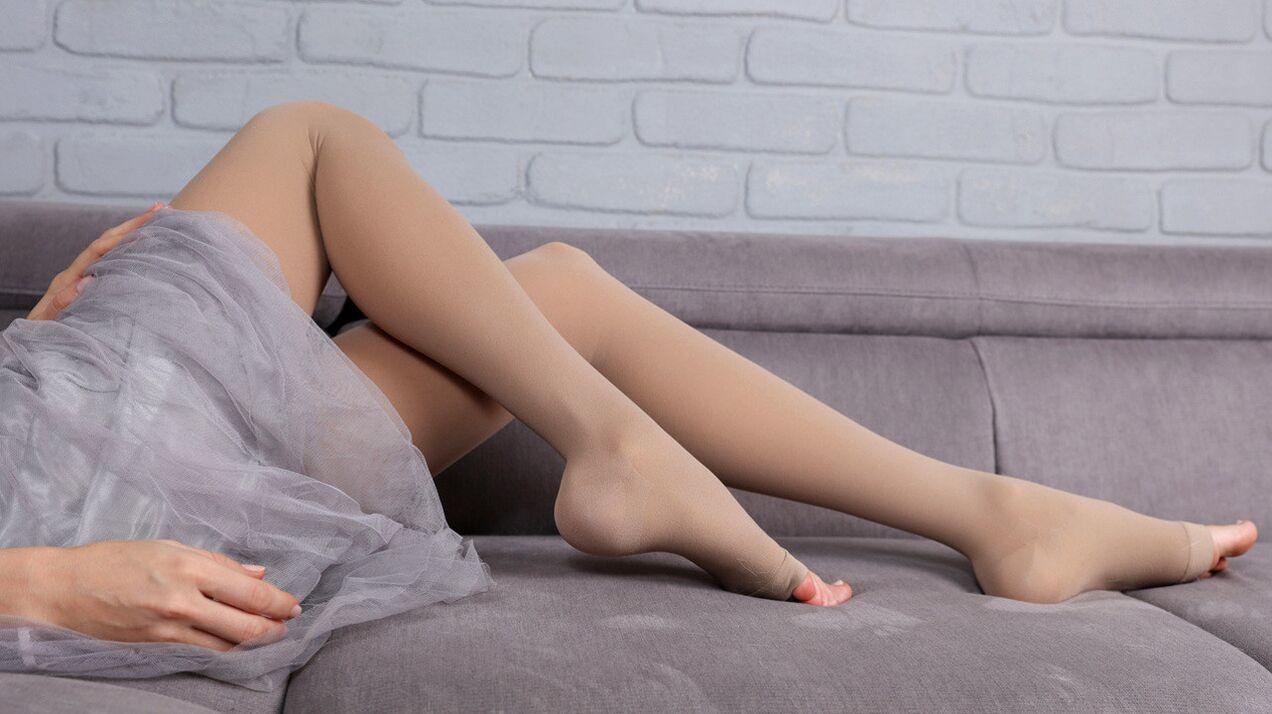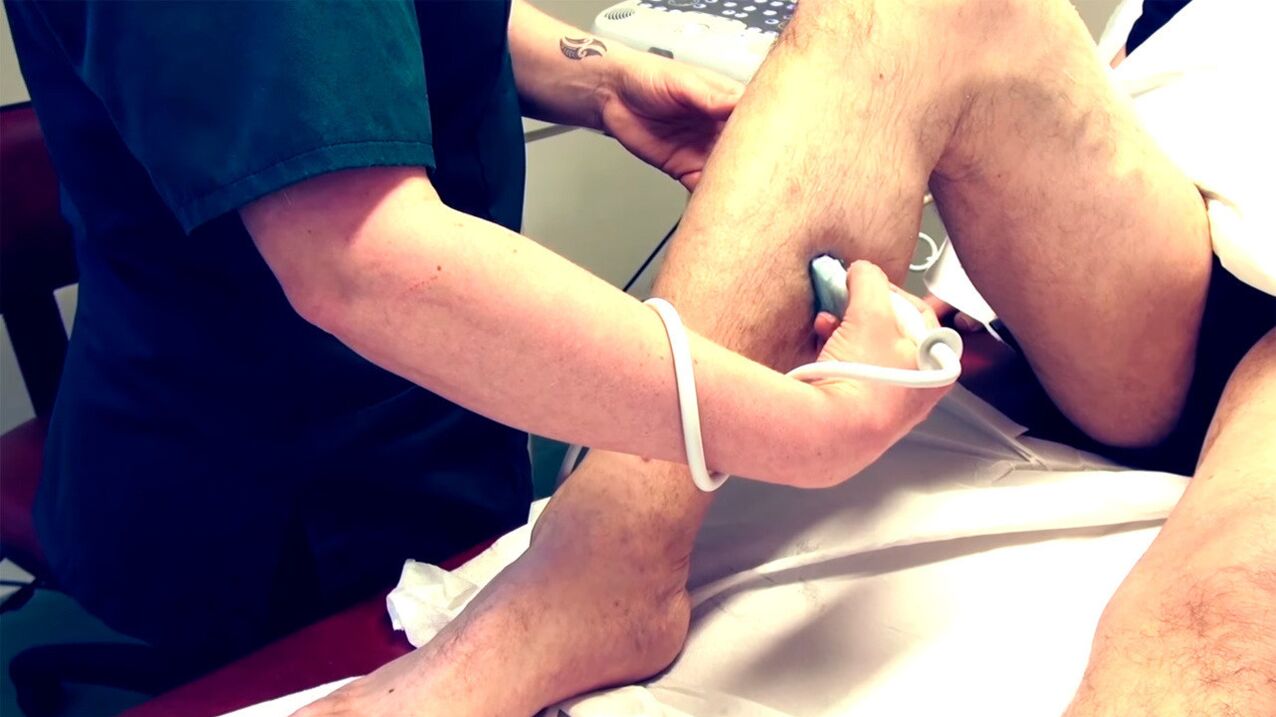
Lower extremity varicose veins are usually asymptomatic in humans. Often, the only problem with this condition is an aesthetic leg defect caused by protruding superficial veins. In this case, the disease may be accompanied by pain or increased sensitivity of the skin on the legs. Depending on the severity of the disease, the patient receives non-drug, drug or surgical treatment. Read more about early symptoms of varicose veins, the nature of its course and effective methods of treatment and prevention, read our material.
What is that
Varicose veins are a condition that only people suffer from. Animals do not have this problem, which suggests that the disease is associated with upright posture. When a person got up, most of the circulating blood was below the level of the heart. In this case, all the conditions are created for the blood to circulate worse in the opposite direction, which leads to stagnation.
According to statistics, some disorders of the venous system are observed in 80% of people in developed countries. In addition, more and more often, similar problems are found in people at an early age. Most likely, one of the reasons why varicose veins "get younger" is sedentary lifestyle, which only contributes to stagnation.
Interestingly, in the age group below 20 years, varicose veins in the lower extremities occur with the same frequency in men and women. However, from the age of 20 onwards, women start to predominate in the morbidity structure. This is due to pregnancy and childbirth, which are an important factor in the development of venous disease.
Characteristics, causes and development mechanism of varicose veins

The exact reasons for the development of varicose veins in the lower limbs are still unknown. Currently, it is believed that the disease is caused by congenital or acquired defects in the valve system of the veins of the lower limbs.
For an unobstructed ascending blood flow through the veins, a well-coordinated work of the venous valves is necessary. These valves only open for blood flowing upward. However, with a valve defect, partial downward blood flow is also possible. This is how venous insufficiency develops, manifested by edema, leg muscle cramps and expansion of venous vessels.
Leukocytes may also be involved in the pathogenesis of developing varicose veins. This issue is now being actively studied. It is assumed that with the prolonged accumulation of leukocytes in the tissue of the vessels (in particular, in the area of the valvular apparatus), an inflammatory process develops, spreading along the venous bed.
Since venous valves are subject to constant mechanical stress, inflammation develops especially quickly in the region of the venous valve apparatus.
Now, the vast majority of people in developed countries lead sedentary lives. But why then doesn't everyone have varicose veins? Consider the main risk factors that contribute to the appearance of this pathology:
- hereditary factors. . . Although the specific hereditary mechanisms that are associated with the development of varicose veins have not yet been established, most experts agree with the presence of such a factor. At the same time, there are strong counterarguments regarding heredity in the development of varicose veins. For example, this is the prevalence of varicose veins in ethnic Africans and African immigrants who left to live in the United States. If the prevalence of varicose veins among sedentary Africans is about 0. 5%, then among emigrants that number reaches 20%. These numbers show that hereditary factors, at least, are not the only ones in the development of the disease and, very likely, do not prevail.
- Obesity. . . Overweight and obese people are at risk. It is important to note that obesity contributes to varicose veins both by increasing the stress on the vessels and by the risk of other diseases that affect the vessels (diabetes mellitus, hypertension and others).
- Pregnancy. . . This is one of the most obvious factors in the development of varicose veins in the lower extremities. In this case, the main risk factors are the increase in the volume of circulating blood, as well as the compression of the retroperitoneal veins by the developing fetus in the uterus. According to epidemiological studies, second and subsequent pregnancies lead to a significant increase in the probability of developing varicose veins. After the first pregnancy, the probability of varicose veins in the legs remains low.
- hormonal imbalance. . . Hormones are involved in the pathogenesis of most diseases. These pathologies include varicose veins. This issue is especially true for women who are taking hormonal contraceptives, as well as women who are using hormone replacement therapy for the treatment of certain illnesses (eg, osteoporosis) or during the premenopausal period. It has been established that female sex hormones (in particular, estrogens and progesterone) reduce vascular tone and destroy collagen fibers. Thus, the wall of the veins is pathologically dilated.
- Lifestyle. . . A person's lifestyle has a great influence on the course of the illness. A sedentary lifestyle, as well as work associated with standing or sitting for a long time (eg, security guards, drivers, office workers, contractors, and others) contribute to the development of varicose veins. You must also pay attention to nutrition. The lack of a sufficient amount of vegetables and fruits in the diet worsens the condition of the blood vessel walls.
Stages of varicose veins of the lower extremities
Currently, several classifications of varicose veins of the lower limbs are used. The international CEAP classification, adopted in 1994, is considered generally accepted. CEAP is an abbreviation, where each letter corresponds to the name of a classification category:
- C (clinical)- the clinical class of the disease (type of affected veins, presence of pigmentation, eczema, trophic ulcers).
- E (etiological)- the etiology of the disease (congenital, primary, secondary).
- A (anatomical)- anatomical location of the pathology (superficial or perforating veins).
- P (physiopathological)- the type of disorder (venous reflux, obstruction or a combination of both).

The course of the disease occurs in six phases:
- stage zero. . . The early stage of varicose veins, where even doctors cannot make a reliable diagnosis. At this stage, there are no outward signs of the disease. Ultrasound diagnosis does not show the presence of pathology. At the same time, a person in stage zero is concerned about symptoms such as swelling, a feeling of heaviness in the legs, and cramps, which indicate the presence of blood vessel problems.
- First step. . . In the first stage of the disease, spider veins are visible on the skin surface of the legs, whose diameter is less than 1 millimeter. Medium sized veins can increase in diameter by up to 3mm. At this stage, physicians are not always able to establish the correct diagnosis, as the presence of these asterisks does not always indicate varicose veins.
- second stage. . . At this stage, veins can appear and disappear depending on conditions. For example, veins appear clearly after sitting for a long time, standing or lifting heavy objects. The diameter of varicose veins at this stage is 3 mm or more. Blood clots usually form in the second stage.
- third stage. . . If in the earlier stages of the disease the swelling of the legs appeared and disappeared, in the third stage the edema becomes permanent. The swelling in the legs is more intense at night.
- fourth step. . . At this stage, significant trophic changes occur. In particular, tissue nutrition is interrupted near the affected veins. The patient develops skin changes such as lipodermatosclerosis (inflammation of the subcutaneous adipose tissue), eczema, in addition to darkening or discoloration of the skin. For the fourth stage of the disease, pigmentary changes are characteristic. For example, the skin in the area of affected vessels may turn brown and even black, which indicates the concentration of pigment in that area. The opposite is also possible when, due to a pathological process, the pigment does not penetrate the affected area, which leads to the appearance of a pale skin tone. If the varicose veins are not treated at this stage, the problem will only worsen with the appearance of trophic ulcers.
- fifth stage. . . At this stage of the disease, in addition to the above symptoms, trophic ulcers also appear, which heal quickly. If you don't take any steps for treatment, ulcers will continually appear.
- sixth step. . . Trophic ulcers appear that do not heal. In the affected area, the temperature rises sharply and there may be pus leaking from the wounds.
You should not wait for the last stages to develop - you should go to the doctor on Monday to record and monitor the dynamics of the disease. Sometimes symptoms get better on their own and sometimes they progress quickly. Therefore, it is important to monitor the situation in order to act in time.
Symptoms

Consider the main symptoms of lower extremity varicose veins at different stages of the disease:
- Pain. . . This is the first sign of the disease. As pain is a non-specific symptom, it is impossible to establish a diagnosis based on this symptom alone. With varicose veins of the lower extremities, the pain is usually located along the venous trunks.
- feet on legs. . . It also applies to the first symptoms, while the veins in the skin are not yet visible. Often, the feeling of heat is accompanied by a throbbing pain.
- Cramps and itchy muscles. . . Most often disturbed at night.
- Swelling in the legs. . . In the early stages of the disease, swelling is minimal and transient. As a rule, they appear at night and disappear in the morning. However, as the disease progresses, the severity increases and they become permanent.
- skin discoloration. . . As a rule, in varicose veins, the skin on the lower extremities darkens. In the area of affected veins, the skin turns brown. In the advanced stages of the disease, eczema and dermatitis appear. The terminal stages of varicose veins are characterized by the appearance of trophic ulcers. Initially, these are healing ulcers, but later on there are wounds that do not heal.
- vascular spiders. . . In medical literature, these asterisks are called telangiectasias. In some people, varicose veins may be limited to spider veins, with no progression to larger veins.
- Twisted dilated veins. . . The most characteristic sign of varicose veins is the dilated veins twisted on the surface of the legs.
In summer, symptoms of varicose veins become more pronounced. This is due to the high ambient temperature, which already contributes to the expansion of the veins. Therefore, during the hottest hours, from 10: 00 am to 4: 00 pm, it is best to be in a well-ventilated place.
when to see a doctor
You should see a doctor at the very first symptoms of the disease - pain, swelling, or spider veins. As the early stages of varicose veins are difficult to diagnose, they may initially be misdiagnosed. The patient must carefully monitor the condition of the legs and be regularly observed by a phlebologist.
Diagnosis

The diagnosis of varicose veins of the lower extremities is reduced to the following activities:
- External examination of the skin of the legs;
- Doppler ultrasound;
- Duplex scan of veins;
- Phlebography.
treatment characteristics
Lower extremity varicose veins are treated with conservative and surgical methods. Conservative treatment is reduced to the following activities:
- drug therapy. . . It is the ingestion of medications that improve the tone of the venous walls. In addition, the patient receives medications that reduce capillary permeability and improve blood microcirculation. If there is a risk of blood clots, anticoagulants are also prescribed.
- compression therapy. . . It is the use of special compression socks, which reduce the weight on the leg. The benefit is that it is possible to distribute the load evenly, even with great physical effort. By wearing compression garments, congestion and swelling can be avoided.
- Corrective gymnastics and lifestyle changes. . . The patient is advised to do exercises to relieve tension in the legs. It is important to avoid sitting or standing for too long. If you have to stand or sit for a long time at work, you will need to take breaks more often.
If conservative varicose vein therapy does not bring the expected results, then the decision is about surgical intervention. Most of the time, these are minimally invasive interventions, including:
- sclerotherapy- the introduction into the vein of substances that stick to the walls of the affected vessel. This treatment leads to the reabsorption of the spider veins.
- laser coagulation- introduction of a laser light guide into a vein and laser irradiation of the walls, which also leads to wall sticking and subsequent vessel reabsorption.
- Radio Frequency Removal- bonding of veins by means of a high-frequency current.
- Phlebectomy- Removal of affected veins, in which blood circulation has deteriorated by 90%.
In some countries, you can have the operation free of charge under mandatory medical insurance. But it is not a fact that all types of mandatory insurance transactions are offered everywhere. In any case, there will be help, but you need to know if it will be a conventional or laser removal.
Contraindications for people with varicose veins
- sedentary lifestyle. . . It is important to avoid sitting or standing for too long. Physical activity will help prevent congestion in the veins.
- Running and vigorous exercise. . . With physical activity, it's important not to overdo it. If you have varicose veins, walking is definitely better than running.
- Unbalanced and unhealthy diet. . . You need to give up junk food, even if it looks like your health allows it. Limit the intake of sweets, semi-finished products, rich meat broths and smoked meats. But eating more vegetables and fruits would be a good idea.
- Hot Tubs and Showers. . . For people with vascular problems in the extremities, excessively hot and prolonged procedures with water are contraindicated.
Complications of varicose veins
Varicose veins can be complicated by trophic ulcers, phlebitis (inflammation of the veins), and deep vein thrombosis. The last is the formation of blood clots in deep veins that threaten human life.
Conclusion
Symptoms of varicose veins in the lower extremities, as a rule, do not appear immediately. Different people have a different set of manifestations. For example, sometimes with this pathology there is no edema or there is no local increase in temperature or pain. This in no way means that there is no disease. A timely visit to the doctor will significantly slow down the progression of the disease or even stop it, preventing the development of trophic changes.























